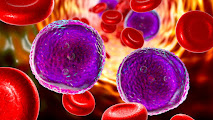 |
| Viral Human Body |
To see how an infection functions, it is important to think for tiny scopes. At a so limited scale that the natural eye would never see the developments of an infection. Truth be told, infections are minuscule microorganisms in the world, yet they can make an individual wiped out and even kill.
Then, at that point, the inquiries are: How can something so little make an individual so wiped out? How does an infection repeat inside the body until it taints someone else? Would we be able to try not to become ill within the sight of an infection?
They are more normal than you might suspect
The main thing you should know about infections is that they are little bits of RNA (ribonucleic corrosive) or DNA (deoxyribonucleic corrosive), enveloped with a layer of proteins, which secure their hereditary material. This implies that they can't reproduce all alone, so they need a host cell to have the option to live.
They come in totally different shapes: as poles, adjusts, with crowns or round and hollow tails. In any case, it is preposterous to expect to see this with a basic magnifying lens. To see an infection, it is important to utilize an examining electron magnifying lens, which utilizes electrons rather than light to deliver a picture. Pharma consulting companies provides you that magnifying lens.
Another significant reality is that there are many kinds of infections. Some can worthy motivation a typical influenza, while others can be more unsafe like HIV, Ebola or Coronavirus. Also, there are infections that enter the human body, however the resistant framework figures out how to battle them, so the individual doesn't become ill.
To put it plainly, infections can recreate and make other infections. This is conceivable as they can adjust effectively to any climate and any host. They are made to endure truly challenging conditions.
How would they enter the body?
Normally these microorganisms enter the body through the mouth, eyes, nose, private parts or through injuries, chomps or any painful injuries. Besides, they are sent through various courses.
A few illnesses are spread by direct contact with contaminated skin, mucous layers or body liquids. There is likewise the chance of aberrant contact, when an individual contacts an item (entryway, handle, table), which has the infection on it, when a tainted individual wheezes, hacks or talks or when the mucous layer comes into contact with someone else.
In some different cases, the infection is communicated through normal vehicle like polluted food, water or blood. At long last, there are vectors: rodents, snakes, mosquitoes and so forth, which communicate the infection to people.
The infection inside the human body
These life forms enter the body and hold fast to the cell surface. Contingent upon the sort of infection, it looks for cells in various pieces of the body: liver, respiratory framework or blood. Whenever it has connected itself to the sound cell, it enters it.
At the point when the infection is inside the cell, it will open up with the goal that its DNA and RNA will come out and go directly to the core. They will enter an atom, which resembles a processing plant, and make duplicates of the infection. These duplicates will emerge from the core to be collected and get protein, which ensures their DNA and RNA.
These new duplicates of the infection (a large number of duplicates) will pass on the generally tainted cell to contaminate other solid cells, where they will increase once more. Tainted cells can be harmed or kick the bucket while facilitating an infection.
It is critical to explain that when an infection contaminates a human, it doesn't generally wind up in an illness. The disease happens when the infection starts to increase. Furthermore, the sickness happens when many body cells are harmed by the contamination, which is likewise when the indications and disease show up.
Basically, assuming the resistant framework figures out how to fend off the infection that entered the phones and duplicated, the individual won't become ill. By the by, the body will react in various ways to battle these unfamiliar bodies.
At the point when the invulnerable framework neglects to control the infection, a cycle called pathogenesis starts. The infection crosses hindrances, for example, distance, the safe framework or mucous layers to arrive at various organs.
When it starts to reproduce, the individual will become ill and his/her organs will be tainted. Contingent upon how serious the indications are, the individual should rest or look for clinical assistance.
How to battle the infection?
The insusceptible framework is the body's first line of protection. Assuming it can't battle the infection since it has effectively contaminated a few organs, a treatment can be utilized to calm the manifestations (irritation of the organs that produces hack, cerebral pain, and so forth), until the safe framework can guard the body. Named patient program provides imported medicines to battle these infections.
In like manner, drugs, like antivirals, might be utilized as they get inside the cells and are incorporated into the genomes of the infection to prevent it from imitating. This implies that antivirals harm the infection DNA ties to keep them from working. Accordingly, imported medicines in india these medications are utilized to battle infections like herpes or hepatitis C.
Then again, infections can be forestalled with immunizations. These days, this is the most proficient methodology utilized. The immunization creates a particular resistance against an illness since it trains antibodies and cells to perceive the irresistible specialist.
Taking everything into account, infections are microorganisms that can possibly live assuming they track down a host When they track down it assuming they figure out how to defeat all regular and logical obstructions that the body produces, they can contaminate the individual. Additionally, assuming that they figure out how to beat the invulnerable framework, the individual will become ill.
Despite the fact that it is difficult to keep any infection from contaminating people, through the experience of ages and the assistance of science, the human body ought to have the option to guard itself from unfamiliar specialists.

























